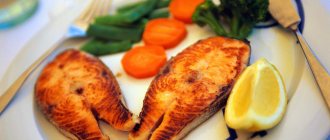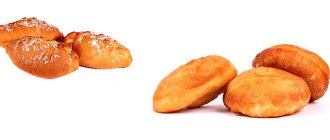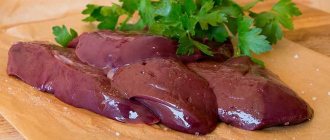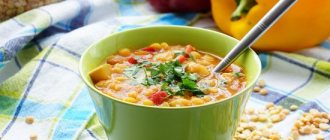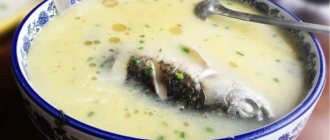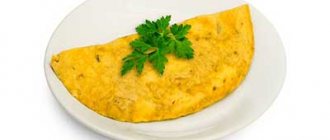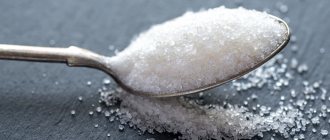Almost everyone eats pollock, but some don't realize it. It does not belong to valuable fish species, but is important in the food industry. This amazing fish is on the menu of expensive restaurants and fast food chains. And its chopped fillet is used as a raw material for the production of cheaper seafood analogues. In terms of nutritional value, pollock, like salmon, tuna and cod, is a good source of lean protein, selenium, phosphorus and vitamin B12.
Biological characteristics
Content:
- Biological characteristics
- The nutritional value
- Beneficial features
- Important Components
- Who needs pollock
- How to choose the right pollock
- Why is this fish dangerous?
- What to cook from pollock
- Surimi at home
Pollock is one of the most important bottom fish for the industry. In the fishery it ranks second after the Peruvian anchovy. Belongs to the cod family, like other representatives of this genus, has 3 dorsal fins and mustache. You can recognize this inhabitant of the seas by its olive-green belly and splashes on its body, large eyes and protruding lower jaw. An adult fish can reach 30-90 cm and weigh from half a kilogram to 800 g. It thrives both in shallow water and at depths of up to 200 m, although during the day it usually moves between the seabed and the surface of the water. Natural habitat is the cold waters of the North Pacific Ocean. Large catches of this fish can be expected along the western coast of America and the eastern coast of Asia. During the spawning period, when schools of fish swim close to the shore, it is easy to catch even with a fishing rod. It is important that if it is caught in the bays of Alaska, near the Aleutian Islands, or in the waters of the Bering Sea, you do not have to worry about the fish being contaminated with mercury or other chemicals. By origin, pollock can be Russian or from Alaskan waters. Russia's fishing industry is concentrated in the Sea of Okhotsk and Bering Sea.
This relatively fast-growing fish feeds on crustaceans, krill and other small sea creatures. The average life expectancy is up to 17 years, but fishermen value 3-4-year-old carcasses most of all. During the mating season, female pollock are especially interesting for their eggs. But despite this, pollock is not an endangered species. And the main reason is that it reproduces very quickly. In a few days, female pollock lay hundreds of thousands of eggs, from which from 100 thousand to a million offspring are born after 9-28 days.
In the period before spawning, the meat of this fish is valued, from which, in addition to fillets, they make fish sticks and surimi - an imitation of crab meat.
The nutritional value
The flaky texture and subtle aroma make pollock an exceptional product. Although, for the sake of fairness, it is worth noting that this fish does not belong to varieties with a pronounced taste. And this is one of the reasons why pollock is not extremely popular. However, among the main advantages is the fact that this fish contains virtually no mercury, which makes it a safe alternative to many other seafood products. In addition, pollock is an important source of amino acids, chemicals necessary for the construction of protein blocks.
It is impossible to talk about the beneficial properties of pollock without recalling the vitamins contained in this fish. And it is rich in B vitamins (B1, B2, B6, B9), antioxidant vitamins A and E, and also contains ascorbic acid. Minerals are represented by a complex of zinc, iron, chromium, copper, iodine, nickel, manganese, molybdenum, fluorine and cobalt.
A 100-gram serving of pollock will provide the body with Omega-3 fatty acids in a serving of 400-500 mg.
In addition, it contains enough Omega-6 fats. The nutritional composition of pollock largely depends on the method of preparing the fish. For example, a breaded, fried product will be higher in calories and contain a lot of carbohydrates and saturated fat. Surimi has little protein and fat, but quite a lot of carbohydrates. But absolutely all pollock products contain Omega-3, although in different concentrations. Table of content of useful components in 100 g of raw product
| Calorie content | 72 kcal |
| Squirrels | 17 g |
| Fats | 1 g |
| Carbohydrates | 0.1 g |
| Water | 80 g |
| Cholesterol | 50 g |
| Ash | 1.3 g |
| Vitamin A | 0.01 mg |
| Vitamin B1 | 0.12 mg |
| Vitamin B2 | 0.11 mg |
| Vitamin B3 | 4.5 mg |
| Vitamin B6 | 0.2 mg |
| Vitamin B9 | 0.05 mg |
| Vitamin C | 0.6 mg |
| Vitamin E | 0.4 mg |
| Calcium | 41 mg |
| Sodium | 41 mg |
| Magnesium | 56 mg |
| Phosphorus | 245 mg |
| Potassium | 418 mg |
| Iodine | 0.2 mg |
| Fluorine | 0.8 mg |
| Copper | 0.2 mg |
| Sulfur | 174 mg |
| Zinc | 1.1 mg |
| Iron | 0.9 mg |
| Chlorine | 164 mg |
Composition and calorie content of pollock
100.0 g of pollock fillet contains 15.9% protein, 0.9% fat and 0% carbohydrates. The calorie content of pollock is 72 kcal for every 100.0 g of product.
The mineral and vitamin composition of fish is surprising in its diversity. Therefore, the benefits of pollock are beyond doubt. Nutritionists and doctors recommend including it as often as possible in your diet.
The beneficial properties of pollock for human health are also explained by the presence of vitamins (A, PP, B1, B2, B9), iron, sulfur, phosphorus, magnesium, calcium, and polyunsaturated fatty acids.
Beneficial features
Pollock is not a fatty fish. This product is useful for obese people, as well as people who, for other reasons, are contraindicated to consume fat.
In addition, fish contains cobalt, which regulates lipid and carbohydrate metabolism. On the other hand, pollock, thanks to its rich mineral and vitamin composition, is useful for maintaining general health, as well as for restoring the body after illness.
This type of fish is recommended to be included in the diet of smokers, who, as a rule, experience problems with their gums and teeth. Ascorbic acid, fluoride and other components contained in fillets help strengthen gums. This product is also useful for people who care about their hair, nails and skin. It is necessary to activate the production of enzymes, as well as restore the correct chemical composition of the blood.
Nutritionists advise children, especially during periods of intensive growth, and older people to consume this fish. By the way, this is one of the few products that is hypoallergenic; many introduce it into complementary foods for children from 8 months. Nutritionists note the benefits of this fish for pregnant women and women during lactation. It is important to regularly include this sea creature in your menu for people with thyroid disorders or those living in regions with iodine deficiency. By the way, a 100-gram serving of pollock contains the full daily requirement of this element
Important Components
Proteins and amino acids
Pollock is a rich source of protein and provides the body with a sufficient amount of amino acids. The human body needs these elements to build cells and tissues, they support the immune system, and some of them are essential for brain function. Pollock is a product containing the so-called “complete” protein, which contains all the essential amino acids for humans. 150-200 g of fish contains approximately 20 g of proteins.
Choline and vitamin B12
Pollock dishes are a good source of choline and vitamin B12. They are necessary to maintain a healthy nervous system and proper brain function. In particular, choline is important for the proper functioning of brain cells, and vitamin B12 produces a protective substance for nerve cells called myelin. In addition, choline is necessary for the maintenance of cell membranes, and vitamin B12 is necessary for the production of red blood cells.
Phosphorus and selenium
To replenish phosphorus and selenium in the body, it is necessary to introduce sea fish, such as pollock, into the diet. Phosphorus is an essential component of bone tissue. It is also necessary for the formation of cell membranes and DNA. Selenium supports the healthy functioning of blood vessels and regulates the functioning of the thyroid gland, preventing the formation of cancer tumors.
Who needs pollock
Considering the chemical composition and beneficial properties of this fish, we can say that for some diseases and conditions of the body, pollock serves as a therapeutic and prophylactic product.
It is important to take care of the presence of this fish in the diet when diagnosed:
high cholesterol;- instability of blood pressure (especially jumps in the direction of a sharp decrease);
- atherosclerosis or the risk of this disease;
- chronic weakness and fatigue;
- thyroid dysfunction;
- disruption of the digestive organs.
In addition, pollock is useful for:
- increased mental work;
- slagging of the body;
- general weakness after illness;
- increased stress on the heart.
PP pollock cutlets
You can even make cutlets from this fish! Write down the recipe!
- 400 grams minced fish
- 1 onion. Grind in a blender or finely chop. It will add tenderness and juiciness to our cutlets.
- 1 carrot. Grate on a fine grater.
- 1 egg
- Spices to taste
Mix everything and form pp cutlets. They can be steamed or oven-baked.
How to cook PP cutlets in the oven
Photo: @soulfuel
How to choose the right pollock
Pollock, as is already clear, is a healthy fish, tasty and, most importantly, available for purchase. But in order for it to bring as much benefit to the body as possible, it is important to know how to choose the right pollock carcasses. Here are some tips on what is important to pay attention to.
Before looking closely at the fish, it is worth asking where it was caught. In our latitudes, pollock is caught only in Russia, China and Japan. Although it is almost impossible to find a Japanese product in our markets. If you are offered fish from other countries, you can be sure: it is definitely not pollock.
Next, it is important to study the color and smell of the product. The fillet should be pure white, without yellow or other colored spots. As for the smell, in old fish it is unpleasant and pungent, in fresh fish it is sweetish.
If you are going to buy frozen fillets, you need to carefully examine the ice crust on each piece. Ice on the fish should not be more than 4% of the total weight.
Pollock should be stored at a temperature of minus 18 degrees Celsius or lower.
How to bake pollock in the sleeve
Another interesting option for preparing fish is to bake pollock in a sleeve. This method will make the ingredient tender and juicy. The deliciousness will literally melt in your mouth.
youtu.be/_wFqinab_HY
Grocery list:
- pollock (4 pcs.);
- lemon (½);
- large carrots and onions;
- spices and soy sauce.
Time – 30 minutes.
Step-by-step action plan.
Step 1. Cut the onion into half rings. Coarsely grate the carrots.
Step 2. Place in the sleeve, sprinkle with spices and season with soy sauce.
Step 3. Clean the fish and cut into portions.
Step 4. Season with lemon juice and add to vegetables.
Step 5. Tie the sleeve tightly and place it on a baking sheet.
Bake for half an hour at 200°C. Just remember to make a few holes in the sleeve first so that the hot air can escape, otherwise it will explode. Serve with any side dish and fresh herbs.
Why is this fish dangerous?
As already noted, the advantage of pollock over other marine fish is that it is less susceptible to mercury contamination than other marine inhabitants. But there are still several nuances that in some cases require using this product in limited quantities or abandoning it.
Although quite rare, allergies to pollock dishes do occur. This condition is usually caused by individual intolerance. Secondly, pollock, the absolute leader among fish in terms of protein content, will have to be abandoned by people with protein intolerance. This is also a fairly rare and serious disease. The third reason why it is important to limit the frequency of fish consumption is hypertension. And all because pollock contains a lot of salt in its meat.
If you are not sure whether your body can tolerate pollock, it is recommended to gradually include fish in your diet in small portions.
What to cook from pollock
The meat of this representative of cod is white, soft, with a delicate flaky texture. Due to its high adaptability, it is consumed in various forms. Pollock fillet can be frozen, fried, baked, stewed, and used to make fish sticks, chips, and surimi. The Japanese salt, dry and dry this fish. It is also used to make imitation crabs, shrimp, scallops, feed meal, minced fish, and canned food.
Surimi is produced by grinding pollock fillets, to which other ingredients are added to stabilize the protein, which allows the product to be frozen for a long time without compromising quality. In addition, caviar and liver are used in the food industry. Vegetables are best suited as a side dish for fish dishes.
Energy value of pollock
It will be difficult to find another product as healthy and nutritious as pollock, which will also have similar fat content.
- The calorie content per 100 grams of raw fish is only 72 kcal.
- The prepared piece of fish is thrown into boiling water. The water is slightly salted and a bay leaf is added to it for flavor. With this method of preparation, the calorie content of boiled pollock reaches only 79 kcal.
- The energy value of steamed fish will be slightly higher. The calorie content of steamed pollock in a slow cooker is 80 kcal per 100 grams.
- Stewed pollock is definitely dietary - 75.5 kcal.
- You can also make cutlets from minced fish - less than 80 kcal.
If you cook pollock with minimal addition of fat, then any finished dish will have low energy value. For example, if you bake fish in foil without adding oil, then the calorie content per 100 grams will be only 77 kcal. And the simplest recipe for cooking pollock is initially designed for a diet.
Not everyone will like boiled fish; many people prefer to fry it. But the calorie content of fried pollock will not be as low as with previous options for its preparation.
- The energy value of fish cooked in oil will be 100 kcal, and if it is rolled in flour or breadcrumbs - 127-135 kcal.
- It’s even tastier to cook fish in batter - 280 kcal.
- Smoked pollock is high-calorie - 195 kcal per 100 grams.
- Some believe that dried fish is dietary, but in fact, in terms of energy value, it leaves far behind other options for its preparation. The calorie content of dried pollock is 220 kcal.
- The situation is much better with dried fish, its energy value is 127 kcal.
You can find canned pollock on store shelves. In each specific case, the calorie content should be clarified by examining the label on the jar, which must indicate the composition of the product. For example, pollock with added oil has an energy value of 149 kcal.
Pollock liver and caviar are also sold as canned food, which should be discussed separately. Despite the general low energy value of fish, its liver is several times more caloric than meat. But this organ is incredibly useful - it contains more than 30% of the same Omega-3 and Omega-6 fatty acids.
Advice from nutritionist Irina Shilina Healthy eating is incompatible with strict dietary restrictions, malnutrition and prolonged fasting. Today there is no need to strive for abnormal thinness by depriving yourself of food! Check out the latest weight loss techniques for 2021. Find out the secret ->
And although 100 grams of pollock liver contains 475 kcal, you should not immediately cross out the product from your menu. When choosing canned food, pay attention to the composition: they should not contain anything except liver and salt.
